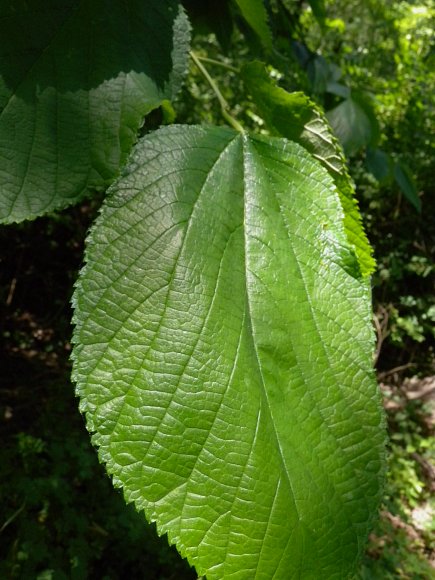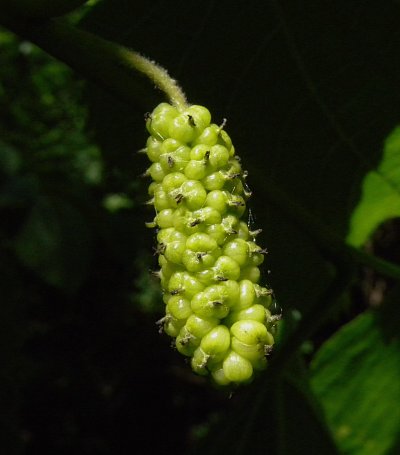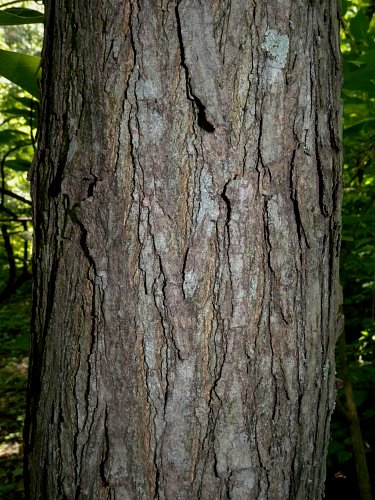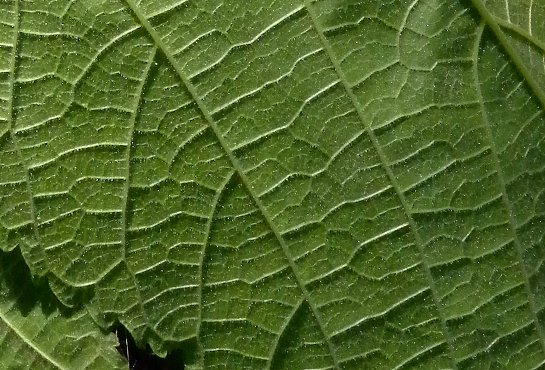
Red Mulberry (Morus rubra) is usually dioecious (male and female flowers on separate trees), although less often it is monoecious (male and female flowers on the same tree). The male (staminate) flowers occur in drooping catkins about 1½-2" long. Each male flower consists of 4 light green sepals and 4 stamens; there are no petals. The sepals are oblong in shape and joined together toward the base; they are finely pubescent. The female (pistillate) flowers occur in catkins about 1" long; the female flowers are arranged densely together. Each female flower consists of 4 light green sepals and a light green ovary with a pair of stigmata; there are no petals. The sepals are oblong or elliptic and finely pubescent; they are joined together at the base. The peduncles of the catkins are about ¼-1" long, light green, and finely pubescent; the rachises (central stalks) of the catkins are also light green and pubescent. The blooming period occurs from mid- to late spring, lasting about 1-2 weeks. The flowers are cross-pollinated by the wind. Afterwards, female catkins become transformed into compound drupes that are berry-like in appearance. Each compound drupe consists of numerous single-seeded drupelets. As the compound drupes mature, they change color from light green, to red, and finally to nearly black. Mature compound drupes are about ¾-1½" in length and short-cylindrical in shape; at this time (typically during early to mid-summer), they are juicy and sweet. Mature drupes remain on a tree for only a short time before falling to the ground. The woody root system is shallow and spreading. The deciduous leaves turn yellow during the autumn.

Cultivation: This tree can be cultivated in full sun to light shade, moist conditions, and different kinds of soil, including those that contain loam, clay, silt, and sand. A wide range of soil pH is tolerated. Growth and development are relatively fast; individual trees can bear fruit in as little as 10 years and they may live as long as 125 years. Leafspot disease organisms sometimes disfigure the foliage. The seeds can be planted outdoors during autumn, or they can be subjected to cool moist stratification for 30-90 days and planted during the spring.
Range & Habitat: The native Red Mulberry (Morus rubra) is occasional throughout most of Illinois, except in the NW section of the state, where it is uncommon (see Distribution Map). Its range extends across the eastern half of the United States. For poorly understood reasons, populations of this tree appear to be declining as it used to be common. Habitats include floodplain woodlands, woodland borders, wooded valleys, limestone glades, and fence rows. Sometimes this tree is found in city parks and other landscaped areas, but it is not often cultivated. Exposure to fire usually kills this tree, possibly because of its thin bark or shallow roots. To a greater extent than the similar Morus alba (White Mulberry), Red Mulberry is found in natural areas with intermediate or low levels of disturbance. It usually occurs as widely scattered trees, rather than forming colonies.

Faunal Associations: Red Mulberry provides a source of food for various insects, birds, and mammals. Among insects, larvae of long-horned beetles bore through the wood or bark of this tree. They include the Mulberry Borer (Dorcaschema wildii), Small Mulberry Borer (Dorcaschema alternata), an unnamed long-horned beetle (Dorcaschema cinerea), and Mulberry Bark Borer (Parelaphidion incertum); see Yanega (1996). Other insect feeders include the Four-humped Stink Bug (Brochymena quadripustulata); Sycamore Lace Bug (Corythuca ciliata); Gloomy Scale (Melanaspis tenebricosa); and several mealybugs, including the Osborn Mealybug (Heliococcus osborni), an unnamed mealybug (Heliococcus stachyos), Comstock Mealybug (Pseudococcus comstocki), and Grape Mealybug (Pseudococcus maritimus); see Rider (accessed 2009), Arnett & Jacques (1981), and ScaleNet (accessed 2014). The early-maturing fruits of this tree are an important source of food for many kinds of birds, including the Wood Duck, Ruffed Grouse, Blue Jay, Baltimore Oriole, Common Grackle, Tufted Titmouse, Wood Thrush, American Robin, and others. Two extinct birds, the Passenger Pigeon (Ectopistes migratorius) and Carolina Parakeet (Conuropsis carolinensis), were avid consumers of the fruits of Red Mulberry (see the Bird Table for a more complete list of these birds). Among mammals, the Opossum, Gray Squirrel, and Fox Squirrel eat the fruits, and undoubtedly many others. Interestingly, even turtles have been observed to eat the fruits of mulberry trees, including the Eastern Box Turtle (Terrapene carolina) and Smooth Softshell Turtle (Apalone mutica); see Martin et al. (1951/1961) and Ernst et al. (1994).

Photographic Location: Along a stream in a floodplain woodlands at Springfield, Illinois.
Comments: Compared to White Mulberry (Morus alba), which was introduced from Asia into North America for an incipient silkworm industry, the Red Mulberry (Morus rubra) is a more shade-tolerant forest tree that is not often encountered in urban and suburban areas. Red Mulberry tends to be a larger tree that is more densely branched, its leaves are less often lobed, and its fruits are longer. The maturation sequence of its fruits causes them to change color from light green, to red, to nearly black. In contrast, the typical variety of White Mulberry has fruits that remain white at maturity, while the fruits of another variety (var. tartarica) of this tree has fruits that change color from white, to red, to nearly black. Red Mulberry can also be identified by the pubescence on the undersides of its leaves (both along the veins and between them) and by the rough texture of its leaf upper sides. In contrast, White Mulberry usually has leaves that are glabrous and smooth on both of their sides. In some areas, these two mulberry species may hybridize, producing trees that have intermediate characteristics. The wood of Red Mulberry is relatively light, soft, and weak; it is not important commercially. However, it has been used in the past to make fence posts, farm implements, furniture, interior finish, and caskets.